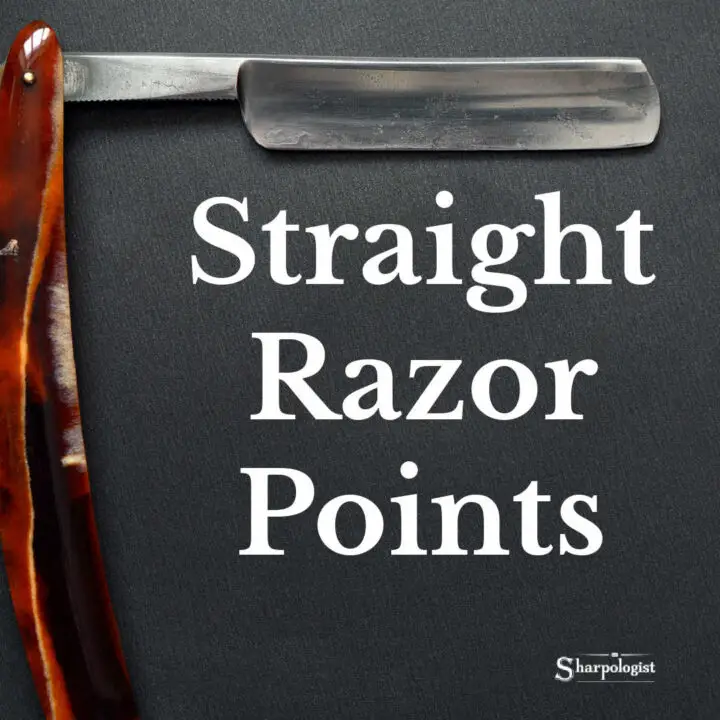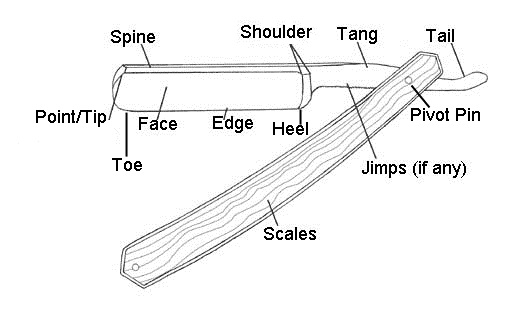
The specifications of a straight razor blade are broadly measured with three factors: the type of grind used for the blade, the blade’s size, and shape of the blade’s point.

Grind gets the bulk of the buzz in discussion forums but then that is because the two other factors tend to be dismissed as aesthetic factors.
But the different types of straight razor blade end points can give their respective razors a distinctive style and efficiency in shaving. Let’s take a look at them.
[Note: Amazon and geni.us links are affiliate.]
Round Point (Dutch Point)

A Round point (sometimes called a Dutch point) is a rounded tip of a straight razor blade. It is probably the most commonly found point on modern straight razors.
Pro
Great for the straight razor beginner: less likely to cause a nick or “nip” compared to most other points.
Con
Less precision for detail work trimming around facial hair.
Example
As mentioned earlier, the round point is the most common straight razor point, with many examples.
One well-regarded, widely available example is the Dovo Bismarck.
Square Point

A Square point has a very sharp point perpendicular to the razor’s edge. Many vintage straight razors have this blade point due to the popular manufacturing methods of the day.
Pro
Provides better control of shaving under the nose, under the earlobes, and shaping hard edges of a beard.
Con
Probably the least “forgiving” straight razor point. Best used by skilled straight razor shavers and not beginners.
Example
An example of a square point straight razor is the Boker Wenge.
Spike Point

A Spike point is very similar to a square point except that the point is slightly off the perpendicular.
Pro
Most accurate for maneuvering around detail areas like under the nose or behind the ear–when used by a skilled shaver.
Con
Reputed to be the most “vicious” of all blade points due to its acute angle.
Example
There are very few spike point straight razors available today. Occasionally vintage examples like this one at Razor Emporium can be found.
French Point (Irish Point)

A French point (sometimes called an Irish point) is a combination of Round and Spike points: it has the sharp edge of a Spike on the lower side but is rounded on the upper side. A French point is reputed to be quite popular with straight razor aficionados.
Pro
Its smaller diameter tip makes it easier to trim facial hair while keeping accidental nicks to a minimum.
Con
Not as precise as either a Square or a Spike point.
Example
An example of a French point straight razor is the Boker Abolone.
Spanish Point (Spanish Notch)

A Spanish point (sometimes called a Spanish Notch) has a subtle concave notch at the blade tip.
Pro
Like the French Point it can provide some precision while offering some protection from necks.
Con
Can damage a strop (not to mention a face!) if not used carefully.
Example
One example of a Spanish point straight razor is the Dovo Bergischer Lowe.
Barber’s Point (Barber’s Notch)

The Barber’s Point (or Barber Notch) is similar to the Spanish point but with a deeper and more pronounced arc. Some traditional straight razor users say that it’s shaped that way to shave the philtrum—that indentation between your nose and upper lip. Others maintain it is simply made that way to allow a barber to open the razor more easily.
The pros and cons of a Barber’s Point are similar to those of a Spanish Point.
Example
One example of a straight razor with a barber’s notch is the Boker Blue Shell.
How To Choose A Point for Your Straight Razor
The best straight razor for you will always encompass more specifications than just the point. And it should also take into account the personal circumstances of the shaver, like whether there is hair to shave around (such as a goatee), their skin type, and their level of shaving expertise.
But specifically considering straight razor blade points, here are some broad suggestions.
For the beginner a Round/Dutch point is probably the “safest” way to go. Though be aware that “safest” is definitely a relative term when it comes to shaving with straight razors.
Barber or French points may be a bit more visually interesting to the straight razor shaver who has had some shave time under their belt. They’re also good for the straight razor shaver who must do detail work on facial hair.
Spanish and Spike points are best left to the straight razor shaving expert who wants to excel at their craft.
Related Post: What Is The Best Straight Razor For Beginners? A Guide By Experts
Summing Up
In conclusion, there are many different types of blade points available for straight razors. Each type has its own advantages and disadvantages. Some people prefer one type over another, while some people like to have a few different types on hand to use depending on the situation. Ultimately, it is up to the individual to decide which type of blade point is best for them.

Good info in this series of articles, Mark–thanks for running it. Question for Joe and you: Is it possible to get a good shave from one pass with an adequately sharpened straight razor? I’d like to get away from the 3-pass DE razor routine, if possible, without getting too aggressive on my skin.
Ed
Comments are closed.